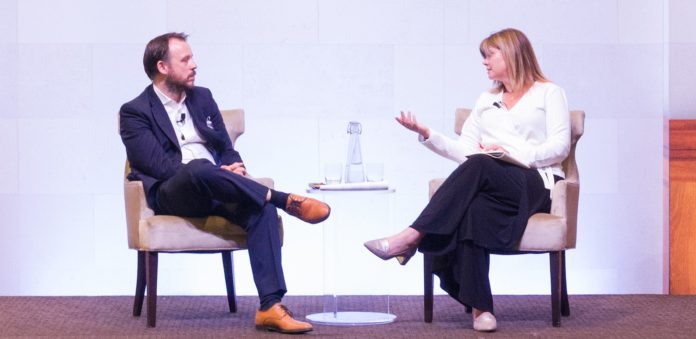The Aspen Institute Financial Security Program (FSP) and Nest Insight are today announcing the Aspen-Nest Insight Transatlantic Collaboration, a partnership dedicated to helping solve the next generation of retirement challenges. For more on this collaboration, see below for a conversation between Nest Insight’s executive director, Will Sandbrook, and Aspen FSP’s executive director, Ida Rademacher. The two organisations have also co-authored a partnership framing paper, which was released today: The Aspen and Nest Insight collaboration framing paper (PDF).
Ida: Aspen FSP is thrilled to embark on this partnership with you and the Nest Insight unit. Our countries are of course different in many ways (for example, our version of ‘The Office’ is quite clearly superior to yours), yet we share a rich and interlocking history. I think together we can accomplish a great deal in terms of translating human insights from both sides of the pond into more effective retirement policy and product solutions that enhance financial security. Tell us why you were in the market for a US partner.
Will: I’ll give you the ‘The Office,’ your version is definitely superior. We’ll have to settle for ‘imitation is the sincerest form of flattery’ (which, come to think of it, is a good catchphrase for much of the relationship between our retirement systems…).
We launched Nest Insight for lots of reasons, but one was that people would approach us at Nest to learn more about what we’ve done and to see if we could work with them on research. Lots of those ideas came from the US given the close similarities between our retirement systems. We wanted to find a more structured way to build on that opportunity for cross-fertilisation between the systems. We picked Aspen FSP as a partner because of your track record and leadership broadening and elevating the debate on critical financial security challenges, and in particular because you share our focus on the low and moderate income groups who have been the least well served historically by retirement provision.
Ida: For those who don’t know, can you describe how Nest came to life and what progress you’ve made thus far?
Will: Nest was established when the UK government decided to introduce mandatory automatic enrolment in UK workplaces. For that to work, people had to be sure all employers would have somewhere to go to meet their obligations. Nest was formed to make sure that was the case. We’re an option for any employer, but employers can also choose to go elsewhere to meet their duties. Progress so far has been great for the broader policy, the industry, and Nest. There’s a vibrant market to meet the demand created by automatic enrolment. So far Nest has grown to over six million members, many of whom are in that low-to-moderate income bracket that pensions have previously found hard to reach.
We’ve been excited to watch US states like Oregon and California unveil their own automatic enrolment reforms. Are you optimistic about auto-IRA going nationwide any time soon?
Ida: As you know, we share your enthusiasm about the states and have tried to support and inform their efforts whenever possible. Ultimately, we’d love to see the idea of automatic enrolment succeed at the federal level and – along with ideas like open Multiple Employer Plans (Open MEPS) – help create the same kind of vibrant new national market that expands retirement savings options to all workers. At this time though, the US trails the UK in adopting a policy goal of universal coverage. So in the meantime, I think the state programs will teach us a lot about how to structure effective, inclusive retirement savings policies, and we’ll also glean important new information about the savings preferences and practices of low and moderate income workers. I also think that the state programs will open up new business opportunities for the private sector, as thousands of smaller firms enter the retirement plan marketplace for the first time. Many firms may seek out a private sector solution, and we hope that demand helps fuel innovation. One of my hopes for this partnership is that we can bring lessons from across the pond to American business leaders and policymakers. To that end, how has Nest spurred private sector innovation in the UK retirement industry?
Will: Like I say, I think a big thing with the way automatic enrolment was introduced in the UK is that employers have to do it, but they have a free choice about which provider to use. Nest is an option but there are many others who were either present in the market already or sprung up in response to automatic enrolment. That creates innovation – for example in how plans integrate with payroll providers to make automatic enrolment easier for employers. But while we’re doing well on near universality of retirement plan coverage and take up, one topic that American researchers are further along on than we in the UK are is understanding financial security more holistically – including income and expense volatility, the relationship between savings and debt, liquid asset poverty, and the role the workplace can play in supporting financial wellness and resilience beyond retirement. So we’ll be looking to you for guidance on that.
Ida: Absolutely. When I returned to Aspen to lead FSP in 2015 it was with the specific goal of using this platform to help create connections between the issues that undermine financial security for US households. And at the same time, I felt that solving those challenges and creating measurable improvements in the financial security of workers would require bold leadership and new kinds of communication and collaboration.
For example, the idea that we need an integrated approach to building both short and long-term financial security seems straightforward. Yet it’s only been in the last five years that there is a robust enough evidence base to help us understand how weekly and monthly financial tensions and trade offs play out at the household level and undermine long term planning. Historically, the experts dedicated to solving the problem of retirement security have rarely intersected with the experts dedicated to addressing the short-term liquidity and cash flow needs of households. I’d like to think that our efforts to translate and amplify research insights, and to curate cross-sector conversations, has helped spur the adoption of a more holistic approach to financial security among employers, financial service providers, and policymakers.
We are looking to do even more research translation and solutions acceleration in the future, and that is why the partnership with Nest Insight is so beautifully timed. Nest Insight has quickly become renowned for using your data to great effect. What role do you see data playing in this relationship? How might we use it to inform the next round of industry and policy advancements?
Will: I think there’s a huge amount more to be achieved with the good use of data in our field. So far, a lot of our work at Nest and in Nest Insight has been through survey data, for example. But I think we’re only scratching the surface of what can be done through interrogation of our administrative data, the potential for combining data to gain a more holistic understanding of what savers need, and also for the use of trials to further supplement the data we can draw on. Later this year we’re launching a field trial of an emergency savings account, for example, working with employers and industry and academic partners. We hope that will provide some real world evidence on the topic you just mentioned – how short- and long-term financial security interact.
We’re excited about showcasing our findings for a new audience, namely American researchers, businesses, philanthropists, and policymakers. I know we’re still at the early stages of planning, but what do you think these constituencies should be on the lookout for over the course of our collaboration?
Ida: Our partnership framing paper – released today – lays this out in more detail, but we’ll be publishing research translation briefs and hosting public and private dialogues. The two issues we’ve decided to focus on during this first stage of the partnership are financial security challenges brought on by the growing trend of non-traditional employment and the increasingly complicated and unstable household balance sheet – so readers should stay tuned for programming centred on those topics. Our hope is that ultimately, by combining efforts, we’ll expand the reach and power of both of organisations’ research and ideas. We hope to build a channel for cross-pollinated solutions to the challenges facing our countries’ respective retirement systems.







